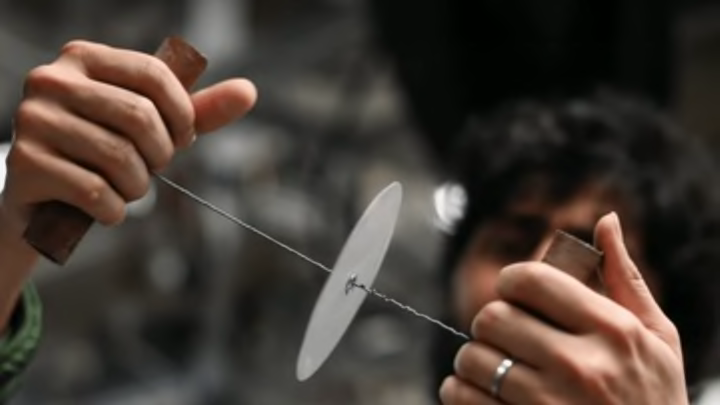Scientists at Stanford University have built a super-cheap, super-fast centrifuge out of everyday items. Their inspiration? A simple spinning toy. The team described their invention in the journal Nature Biomedical Engineering.
Biophysicist Manu Prakash is on a quest to make scientific and medical equipment cheaper and more accessible for everyone. He’s developed parasite-detecting skin patches and computers that run on drops of water. Last year, he made a splash with the introduction of the Foldoscope—an inexpensive, DIY paper microscope that users can assemble themselves. His goal is to distribute 1 million to schools worldwide by the end of 2017.
For his next trick, Prakash turned his attention to the centrifuge, a machine that spins rapidly to separate blood samples into their component parts. Centrifuging is a basic and crucial element of conducting blood tests like the one for malaria, yet many clinics around the world either cannot afford a machine or don’t have access to the electricity required to power it. “I realized that if we wanted to solve a critical problem like malaria diagnosis,” Prakash said in a statement, “we needed to design a human-powered centrifuge that costs less than a cup of coffee.”
He brought the problem back to his lab and began brainstorming with postdoctoral research fellow Saad Bhamla. They realized that the centrifuge’s primary job is simply to spin—the same job shared by thousands of years of children’s toys. They brought in armloads of old toys and pieces and set to work playing with them.
One evening, Prakash was spinning a simple whirligig device that he’d made from a button and some string. He decided to set up a high-speed camera to see how fast the thing could go. When he checked the tape, he was amazed. The crude setup was powerful enough to get the button spinning 10,000 to 15,000 times per minute.
The next step was rigging the center disk to hold and process samples. After a few weeks of experimentation, Prakash had his prototype: a paper disk loaded with thin tubes of blood.
Not content to let it rest there, he and Bhamla recruited a team of mathematicians and asked them to optimize the new paper machine. “We realized that this is a toy that no one had thought about,” he told The Atlantic. “The physics of how it works weren’t understood, and its fundamental limits were completely unknown. So we spent six months thinking about the math, all with the goal of asking how fast it could really go.”
The answer: a staggering 125,000 revolutions per minute—which the team believes is the fastest rotational speed ever recorded for a human-powered object. (“We have submitted an application to Guinness World Records,” they note in the paper.) This “paperfuge,” as they call it, can separate liquid blood from plasma in just two minutes. In 15 minutes, it can extract malaria parasites from a drop of blood.
This exceptional speed is just part of the paperfuge’s appeal. The rest comes in its dirt-cheap construction. The final prototype is made out of waterproof paper, Velcro, drinking straws, and fishing line. It weighs less than 2 grams and can be produced for about 20 cents. And this, Prakash says, is the key: “Frugal science is about democratizing scientific tools to get them out to people around the world.”
